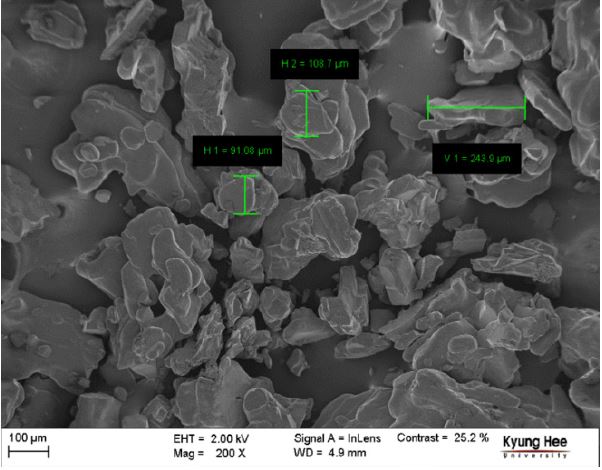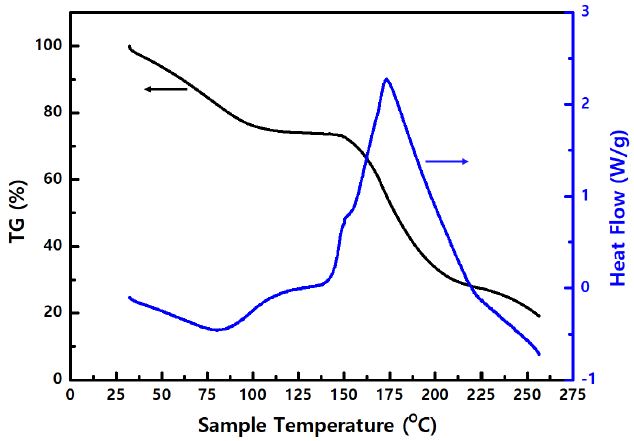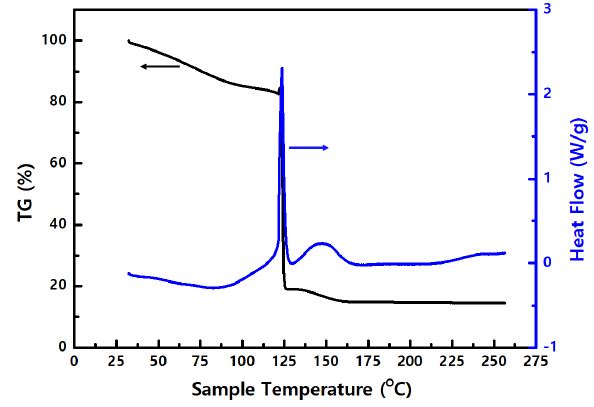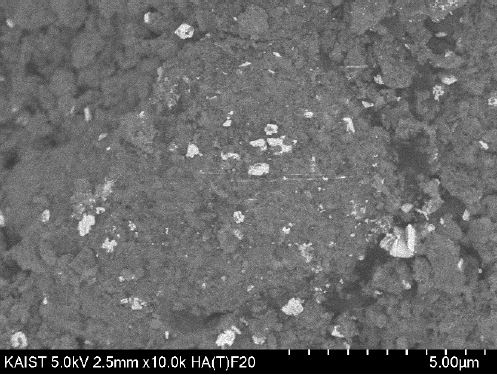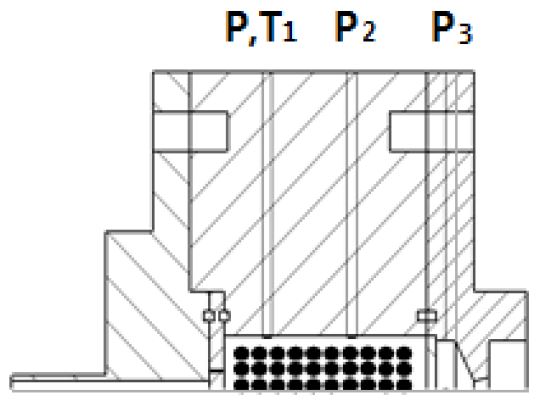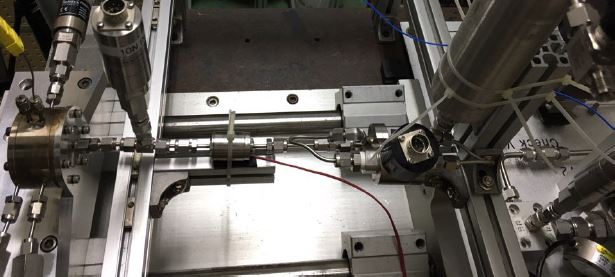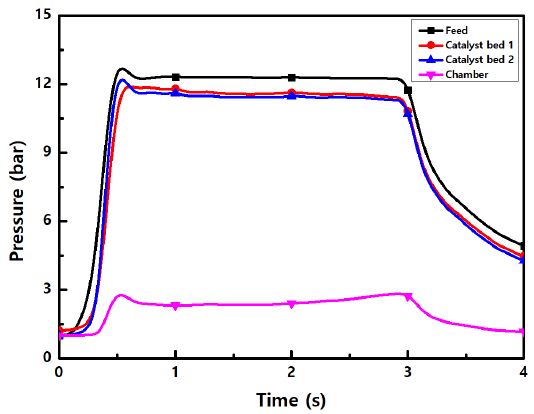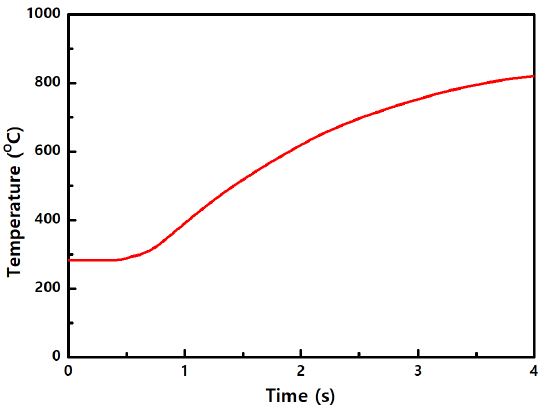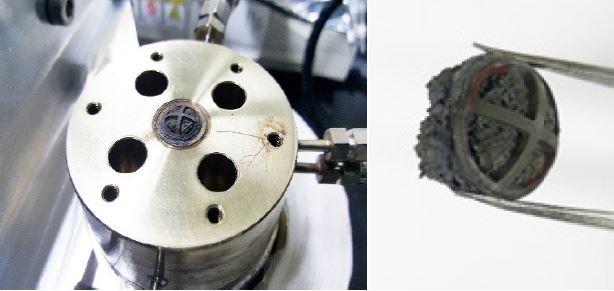
5 N Scale Preliminary Thruster Test with an ADN-based Monopropellant
Copyright ⓒ The Korean Society of Propulsion Engineers
This is an Open-Access article distributed under the terms of the Creative Commons Attribution Non-Commercial License(http://creativecommons.org/licenses/by-nc/3.0) which permits unrestricted non-commercial use, distribution, and reproduction in any medium, provided the original work is properly cited.
Abstract
5 N 급 단일추진제 추력기를 이용하여 ADN 기반 고성능 친환경 단일추진제의 연소 시험을 수행했다. ADN 기반 추진제 및 촉매의 제작을 진행했으며, DSC-TG 분석을 통한 검증을 진행했다. 연소시험 시 촉매 반응기 내에서 작은 규모의 연소 불안정 현상이 발생했지만, 촉매 반응기 전단에서의 높은 온도를 관찰하여 제작된 추진제의 촉매 연소가 발생했음을 파악했다. 향후 보다 높은 열적 안정성을 확보하기 위해 추진제의 높은 단열 분해 온도를 견딜 수 있는 촉매의 개발을 수행하고 이를 적용할 예정이다.
초록
This paper reports the preliminary firing test performed with an ADN-based monopropellant using a 5 N scale thruster. ADN-based propellant and catalyst was fabricated and catalytic combustion of propellant was characterized by DSC-TG analysis. Although an explosion in the catalyst bed was occurred, high temperature in the catalyst bed obtained and demonstrated catalytic combustion of the propellant. Preliminary test results motivates the research for catalysts with better thermal stability.
Keywords:
Ammonium Dinitramide, Catalytic Ignition, Monopropellant Thruster, Lanthanum Hexaaluminate키워드:
암모늄 디나이트라마이드, 촉매 점화, 단일추진제 추력기, 란타늄 헥사알루미네이트1. Introduction
ADN-based propellants currently represent the most developed green alternative to supplant carcinogenic hydrazine in liquid monopropellant thrusters. In addition to increased safety and cost reduction in handling and storage, LMP-103S, an ADN-based propellant developed by ECAPS in Sweden, shows superior performance compared to hydrazine. With a density-specific impulse of up to 30% higher, the ADN-based propellant could allow an increase in the payload for NASA LEO and GEO satellite missions of up to 250 kg[1, 2]. In 2009, attitude control on board PRISMA satellite was also successfully carried out by two ADN-based 1N monopropellant thrusters[3]. In the patent literature, catalytic decomposition and combustion is obtained using a pelletized catalyst bed consisting of LHA pellets prepared by sol-gel with the active phase being either Iridium or Platinum/Rhodium. Without specific details about the catalytic performance, it is stated that the adiabatic decomposition temperature is obtained in the chamber with a preheating temperature of 300 ℃[4]. On the other hand, independent researchers led by Batonneau and Kappenstein, prior to and throughout the 7th Framework Program (FP7), have studied the decomposition of aqueous ADN as well as another ADN-based propellant, FLP-106, using Platinum and Copper as bimetallic catalyst and silicon-doped alumina supports prepared by sol-gel; Silicon showed greatest thermal stability compared to other doping agents at a calcination temperature of 1200℃[5]. The tests employed to identify the most performant catalyst consisted of small-scale analysis and batch reactor tests to compare the onset of the decomposition temperature and the rate of reaction after a prolonged contact and heating of the samples[6]. The bimetallic active material impregnated on the catalyst support was shown to reduce the three-step decomposition of 50 wt% aqueous ADN into a one-step reaction initiated at a lower temperature. Furthermore, interest in ADN and another ionic liquid, HAN, for their use in performant green monopropellants, have motivated recent research notably on the model of combustion of ADN, on the catalytic ignition of HAN-based propellants and on new means of ignition such as arc-ignition for ionic liquids using acrylonitrile butadiene styrene fuel grains[7, 8].
In this paper, we present our preliminary firing test results with an ADN-based propellant following the composition of LMP-103S combined with catalytic decomposition and ignition using Pt-Cu/LHA pellets in a 5 N scale thruster to procure and develop green monopropellant thruster to replace toxic hydrazine thruster. The thruster operation is evaluated in terms of pressure and temperature, and used a preheating temperature of 300℃.
2. Experimental Section
2.1 Propellant Fabrication and Characterization
A small quantity of ADN was synthesized in a laboratory-scale experiment at Kyunghee University in Korea and SEM image is shown in Fig. 1[9]. The propellant contains 63% by weight of ADN as oxidizer, 14% of deionized water, 18.4% of CH3OH as fuel, and 4.6% of NH3 used as stabilizer. The above composition follows the research conducted by Wingborg et al., and was previously shown to comply with detonability, storage, toxicity and shock sensitivity requirements from the Swedish Defense Agency (FOI)[10]. Another propellant, the FLP-106, was studied in the framework of the FP7[5]. The properties of the propellants are shown in Table 1[1]. Both propellants have zero oxygen balance for maximum performance, low shock sensitivity and are compatible with the materials used in conventional propulsion systems whereas the HAN-based propellant, AF-M315E, requires titanium components[2]. The FLP-106 has a sensibly lower volatility and higher density compared to LMP-103S making it slightly more performant[11].
The propellant was evaluated using DSC-TG analysis which evaluates the enthalpy changes as well as its decomposition profile, as illustrated in Fig. 2. The thermal decomposition of the propellant shows a different behavior compared to aqueous ADN with a single broad peak at 175℃ due to the inhibiting nature of methanol as discussed previously[5]. The decrease of the sample’s mass is due to the evaporation of the gaseous species and corresponds to the exothermic decomposition reaction observed by DSC. The experiment was performed without a cap to minimize the risk of explosion.
2.2 Propellant Fabrication and Characterization
Commercial Alumina pellets were obtained from Alfa-Aesar, were crushed and then sieved to an 18-20 mesh size. Subsequently, the pellets were impregnated with a precursor solution of Lanthanum, dried and calcinated to form a hexaaluminate support. As a doping agent, Lanthanum will limit the crystallization of alumina at higher temperatures[12]. The impregnation of the active material is performed by conventional wet impregnation. A bimetallic catalyst was selected to decrease the ignition temperature of the propellant, following the analysis of the catalytic decomposition of 50 wt% aqueous ADN by Kamal[6]. The catalyst support, LHA, is first impregnated with Platinum, calcinated and then impregnated with Copper without intermediate reduction. Finally, the catalyst is further calcinated and reduced (Fig. 4). Through this procedure, a portion of the active material may consist in an alloy of platinum and copper. For increased safety, only 5 L of the propellant combined with 8 mg of crushed catalyst were analyzed by DSC-TG. The sample was heated from 25°C to 250°C at a rate of 5 °/min, following an isotherm of 5 min at the starting temperature. According to the results displayed in Fig. 3, the catalytic decomposition temperature occurs at a lower value (129℃) when using a Pt-Cu catalyst than for the thermal decomposition or catalytic decomposition of the propellant using a monometallic Pt catalyst (175℃).
Furthermore, the sharp peak demonstrates excellent catalytic reactivity and higher decomposition reaction rate.
Subsequently, specific surface area (BET) and pore analyses reveal that the porous structure of LHA is sufficiently maintained after a calcination of 5h at 1200℃, with a specific surface area of 24.5 m2/g (Table 2)[4]. SEM analysis was used to evaluate the active material loading, distribution and crystallite size on the catalyst pellets. Five pellets were selected, and EDS point analysis over an area of 200 μm2 gave an average loading for Pt of 4.3% which is much lower than the corresponding weight balance approximation giving 13.7% by weight. The discrepancy between these results may be explained in part by the error involved in EDS analysis which lies around 15% for the elements studied, or by the impossibility of detecting metallic particles lodged inside the pores. Popa shows that Platinum crystallites smaller than 20 nm can be obtained using the same impregnation procedure[13]. The Secondary Electron image below shows white crystals which are larger than the pores of the LHA support (Fig. 5). Platinum is easily distinguished from the other elements due to its higher atomic number, but EDS point analysis reveals that the white particles sometimes consist of an alloy of Cu and Pt. For analyzing the nano-sized Pt crystallites in the pores, however, Transmission Electron Miscroscopy analysis should be considered.
2.3 Thruster Experiment Design
The thruster was designed to produce a nominal thrust of 5 N in space, however, sea-level testing imposed a nozzle expansion ratio of 2.16 resulting in a thrust of 3.6 N. With the help of NASA’s CEA and the enthalpy of formation Fig. 3 Catalytic decomposition by DSC-TG. of aqueous ADN and ammonia from the literature, the propellant properties were obtained in Table 1[14]. The design mass flow rate was 2.08 g/s for the propellant, assuming frozen composition in the nozzle. Sensys PSHD series pressure sensors were used to measure steady, static pressure at two points in the catalyst bed and in the chamber as illustrated in Fig. 6.
Due to the small thruster scale and the minimal diameter of more heat-resistant R-type thermocouples, smaller K-type thermocouples were employed to measure the temperature in the catalyst bed. Nevertheless, since the K-type has a temperature limitation of around 1250 ℃, only the first thermocouple was left in place. The feeding system was simplified to accommodate the small quantity of synthesized propellant, as a result of which, no drain valve, safety check valve and filter were added after the tank, as shown in Fig. 7.
Firing tests were conducted for 3 seconds using a feeding pressure of 12.5 bar considering estimated pressure drops in the catalyst bed, across the injector and the orifice-type mass flow meter. The short firing time is a result of the thruster material limitations and the quantity of available ADN-based propellant.
3. Results and Discussion
3.1 Preliminary Firing Test
The first firing test resulted in a contained explosion in the catalyst bed characterized by a pressure spike in the thruster above the feeding pressure as portrayed in the pressure curve in Fig. 8.
Since the inspection of the thruster and feeding system did not result in any noticeable damage to the equipment, two further firing tests were conducted, leading to the pressure and temperature graphs below (Figs. 9, 10). Measured mass flow rate was 1.13 g/s, average chamber pressure was 3 bar, and the C* efficiency was 53.6%. The sudden increase in mass flow rate at the beginning of the test is related to the high initial pressure difference across the solenoid valve. A cavitating Venturi valve could be used to regulate the mass flow rate and reduce the risk of hard start, which was experienced here. The pressure curve shows that the mass flow rate was well below the design value, at about 1.14 g/s and so was the chamber pressure, at 3 bar. Nevertheless, the elevated temperature measured by the thermocouple located at the beginning of the catalyst bed indicates proper decomposition of the ADN-based propellant as shown in Fig. 10. Furthermore, the thruster operation was also characterized by an invisible plume: Fig. 11 shows the thruster in operation with visible pressure sensors and pre-heating apparatus but invisible exhaust plume due to the exhaust products mainly being carbon dioxide, nitrogen and nitrous compounds.
Examination of the catalyst bed and distributor after the experiment revealed major damages caused by the explosion during the first test, as portrayed in the picture of Fig. 12. The decomposed propellant flow caused the crack inside the damages shown in the Fig. 12, occurred chamber pressure increase during the firing test shown in Fig. 9. The explosion may have been caused by the sudden expansion of air bubbles trapped in the feeding line due to the absence of a bleeding valve. The pressure drop across the injector which stands at a very low 6% of the chamber pressure, may be another cause for instability leading to a hard start. The mass of crushed catalyst pellets on the distributor explains the significant pressure drop from the catalyst bed to the chamber. A better thruster design will have a longer combustion chamber to reduce the thermal and mechanical stress on the pellets and allow the full combustion of the propellant.
3.2 Catalyst Evaluation
The catalyst was characterized once more following the firing tests to examine its thermal stability and the properties can be found in Table 2 below. The specific surface area after the firing test was half of the value prior to the test. By SEM analysis, no significant change in the crystallite size or dispersion was observed, although consistently lower Pt weight percent was identified on the crushed catalyst. These changes could also have resulted from the mechanical stresses generated by the explosion, owing to a maximal pressure of 30 bar in the catalyst bed. However, thermal effects are not excluded since crushing of the pellets in powder form was shown not to affect the nano-porous structure. The picture of the distributor plate in Fig. 12 shows crushed LHA catalyst stuck to the distributor plate.
4. Conclusion
An ADN-based propellant was synthesized in a laboratory-scale experiment and successfully decomposed in a 5 N scale monopropellant thruster. Although the results indicated small explosion and 53.6% of C* efficiency performance, the high temperature in the catalyst bed, steady pressure in the thruster and the invisible plume indicate that the propellant was well decomposed by the Pt-Cu/LHA catalyst. Further tests need to be conducted using different blends of ADN-based propellants in larger quantity to compare their performance and test various catalysts. The results of the pre- and post-firing characterization of the LHA pellets display the limits of commercial alumina at significantly higher temperatures in terms of thermal and mechanical resistance. To improve the durability of the catalyst bed, sol-gel catalyst supports must be considered for optimized thermal stability and catalyst reactivity. In terms of the thruster and feed system design, an injector with smaller orifice holes can be employed, as well as a drain valve if the quantity of the supplied ADN-based propellant is sufficient. Thrust measurement is envisioned to obtain an experimental value of the specific impulse of the synthesized propellant.
Nomenclature
| ADN : | Ammonium Dinitramide |
| BET : | Brunauer-Emmett-Teller |
| DSC-TGA : | Differential Scanning Calorimeter–Thermogravimetric Analysis |
| EDS : | Energy Dispersive Spectroscopy |
| HAN : | Hydroxylammnoium Nitrate |
| Isp : | Specific impulse |
| LHA : | Lanthanum Hexaaluminate |
| SEM : | Scanning Electron Microscopy |
| ρ : | Density |
Acknowledgments
This research was supported by the Basic Science Research Program through the National Research Foundation of Korea (NRF), funded by the Ministry of Science, ICT and Future Planning (2014M1A3A3A0203477).
References
-
Gohardani, A.S., Stanojev, J., Demairé, A., Anflo, K., Persson, M., Wingborg, N., and Nilsson, C., “Green Space Propulsion: Opportunities and Prospects”, Progress in Aerospace Sciences, 71(6), p128-149, (2014).
[https://doi.org/10.1016/j.paerosci.2014.08.001]

- Cardiff, E.H., Mulkey, H.W., and Bacha, C.E., “An Analysis of Green Propulsion Applied to NASA Missions”, Space Propulsion 2014, Cologne, Germany, p1-12, May), (2014.
-
Anflo, K., and Moellerberg, R., “Flight Demonstration of New Thruster and Green Propellant Technology on the PRISMA Satellite”, Acta Astronautica, 65 Issues 9-10 (8), p1238-1249, (2009).
[https://doi.org/10.1016/j.actaastro.2009.03.056]

- Gronland, T.A., Westerberg, B., Bergman, G., Anflo, K., Brandt, J., Lyckefeldt, O., Agrell, J., Ersson, A., Jaras, S., Boutonnet, M., and Wingborg, N., “Reactor for Decomposition of Ammonium Dinitramide-based Liquid Monopropellants and Process for the Decomposition”, WO2002095207A1, Nov), (2002.
-
Batonneau, Y., Brahmi, R., Cartoixa, B., Farhat, K., Kappenstein, C., Keav, S., Kharchafi-Farhat, G., Pirault-Roy, L., Saouabe, M., and Scharlemann, C., “Green Propulsion: Catalysts for the European FP7 Project GRASP”, Topics in Catalysis, 57 Issues 6-9 (26), p656-667, (2014).
[https://doi.org/10.1007/s11244-013-0223-y]

- Kamal, F., “Ergols ioniques pour la propulsion spatiale : préparation, décomposition thermique et décomposition catalytique”, Ph.D. Dissertation, Chemical Biological and Geological Engineering, Université de Poitiers, 15 Rue de l'Hôtel Dieu, 86000 Poitiers, France, (2008).
-
Whitmore, S.A., Merkley, D.P., Eilers, S.D., and Judson, M.I., “Development and Testing of a Green Monopropellant Ignition System”, 49th AIAA/ASME/SAE/ASEE Joint Propulsion Conference, San Jose, C.A., U.S.A., p1-28, Jul), (2013.
[https://doi.org/10.2514/6.2013-3967]

-
Thakre, P., Duan, Y., and Yang, V., “Modeling of Ammonium Dinitramide (ADN) Monopropellant Combustion with Coupled Condensed and Gas Phase Kinetics”, Combustion and Flame, 161 Issue 1 (32), p347-362, (2014).
[https://doi.org/10.1016/j.combustflame.2013.08.006]

-
Kim, W., Kwon, Y., and Jo, Y., “Synthesis and Characterization of Pyridinium Dinitramide Salt”, Journal of the Korean Industrial and Engineering Chemistry, 27(4), p397-401, (2016).
[https://doi.org/10.14478/ace.2016.1049]

- Wingborg, N., Johansson, M., and Bodin, L., “Initial Development of a Laboratory Rocket Thruster for ADN-based Liquid Monopropellants”, Technical Report, FOI-Swedish Defence Research Agency, FOI-R-2123-SE, Tumba, Sweden, (2006).
- Scott, T.H., Applications of Ionic Liquids in Science and Technology, InTech, Rijeka, Croatia, (2011).
-
Lee, S., Kang, S., Kwon, S., and Park, G., “Lanthanum Hexaaluminate Catalyst Support in a Hydrogen Peroxide Thruster”, Journal of Propulsion and Power, 32(5), p3-6, (2016).
[https://doi.org/10.2514/1.b35998]

-
Popa, F., Gautron, E., Rossignol, S., Courtheoux, L., and Kappenstein, C., “Platinum Supported on Doped Alumina Catalysts for Propulsion Applications. Xerogels versus Aerogels”, Journal of Non-crystalline Solids, 350(16), p113-119, (2004).
[https://doi.org/10.1016/j.jnoncrysol.2004.06.051]

- Negri, M., “Replacement of Hydrazine : Overview and First Results of the H2020 Project Rheform”, 6th European Conference for Aeronautics and Space Sciences (EUCASS) 2015, Krakow, Poland, p1-12, Jul), (2015.
